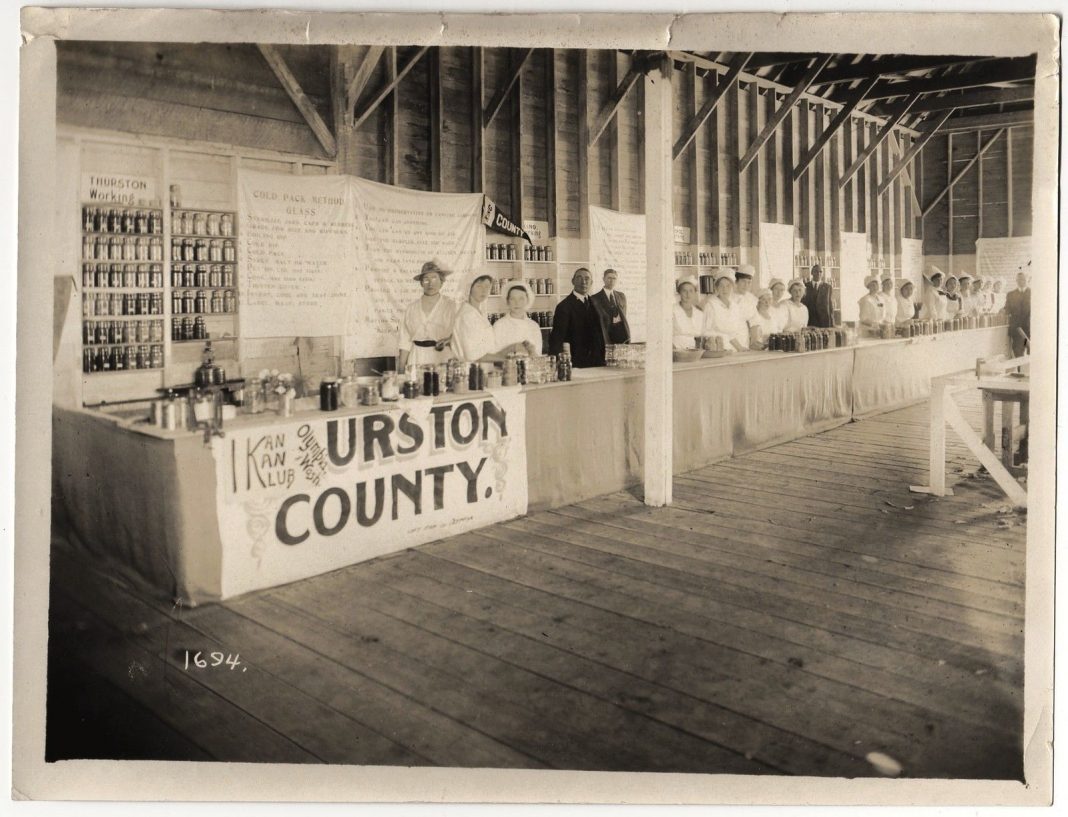During the years leading up to official American involvement in World War I, many people across the nation argued for preparing the American people for eventual participation in the conflict. At the same time, domestic science and home economics were being promoted by school systems. Combining these two programs, thousands of canning clubs were formed around the country.
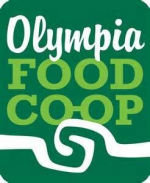 Several canning clubs were established in Thurston Country during the period, mostly after the U.S. declaration of war in April 1917, but the first and one of the most prominent was the Washington School’s I Kan Kan Club in Olympia.
Several canning clubs were established in Thurston Country during the period, mostly after the U.S. declaration of war in April 1917, but the first and one of the most prominent was the Washington School’s I Kan Kan Club in Olympia.
On Tuesday, April 20, 1915, weeks short of two years before the official American declaration of war, the Washington [School] Parent-Teacher Circle held a meeting to organize a canning club. Myrtle Query Setchfield, wife of school Principal Daniel Setchfield and a prominent Parent-Teacher Circle leader, was picked as supervisor. Twenty-four girls joined the group, electing student Gertrude Cone as its first president. Members of the club were female students from the school, most being around nine to eleven years old, as the school included first through eighth grades.
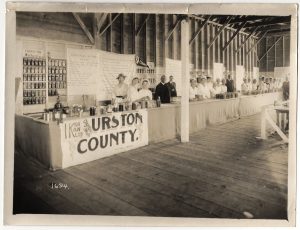
The canning club met mostly in the summer and the early fall. Its weekly activities consisted of holding classes in the Washington School domestic science kitchen and encouraging girls to can at home. These classes sometimes welcomed the public and the mothers of the girls.
By the end of the summer, they had canned and preserved a wide variety of agricultural products: sausage, fish, eggs, pork, beef, chicken soup, chicken stock, chicken loaf, geoduck, hominy, whole wheat, corn, carrots, peas, spinach, beets, beans, asparagus, greens, oranges, raspberries, cherries, loganberries, strawberries, rhubarb, pineapple, gooseberries, jelly, pears, peaches, blackberries, tomatoes, baked beans, string beans, squash and corn salad.
The club produced approximately 1,056 quarts of canned and preserved foodstuffs in the summer of 1915 and 10,670 quarts in the summer of 1917. On March 10, 1917, the club hosted a luncheon at the Washington School for local, county and state dignitaries, including Thurston County commissioners and Washington State Superintendent of Public Instruction Josephine Corliss Preston. They served an elaborate array of 28 varieties of canned goods that they had produced.
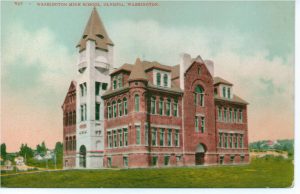
The I Kan Kan club also participated in various fairs and contests. In 1915, they won first prize for canning at the Thurston County Fair which was held at the Carolyn Race Track (now the site of the Sunset Campus State offices in Tumwater.) In 1916, the fair was again held at the race track. The club had an exhibit of canning goods in the manual arts and agricultural tent. In 1917, an Olympia school fair with an I Kan Kan Club display was held in the Lobby, a building at 7th and Adams. In addition, the club sold whale meat sandwiches for ten cents each in an effort to promote whale meat as a cheap beef substitute. In modern times most species of whales are endangered due to over-whaling and pollution.
Besides local fairs, the I Kan Kan Club and other canning clubs in the county participated in the Washington State Fair at North Yakima (now Yakima.) In 1916, a team called the “Invincibles” won the right to go to the state fair. However, they did not win any prizes at the event.
On September 29th, the girls (Lucille Stanger, Muriel Hoage, and Ruth Adair) gave a report on their trip to the fair at the Washington School, setting up their stage to look like their booth in North Yakima. At the same time, they gave a demonstration of canning beans and tomatoes. The following year, canning contests were held between local schools for the honor of representing Thurston County at the State Fair in North Yakima. This year, Alys Jennings (Hayes), Mildred G. Gibson (Bucoda), and Elizabeth Richards (Tenino) were the winning team. The trip was sponsored by the Thurston County Agricultural Board.
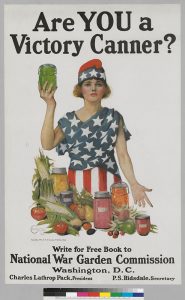
In 1917 the I Kan Kan Club put together an exhibit of 59 types of canned goods at the National Education Association Conference in Portland, Oregon. The club tied with another team in a canning contest at the conference. George E. Farrell, a national boys’ and girls’ agricultural club leader from Washington D.C. was so impressed by the club’s work that he took back samples for a “desk exhibit” in his office.
Canning clubs multiplied across the county, particularly after the declaration of war against Germany and its Allies. They were seen as part of the homefront efforts to conserve food. Myrtle Setchfield was appointed leader of the boys’ and girls’ agricultural clubs of Thurston County by the Thurston County Agricultural Board in May 1917. This included canning clubs. In this position she helped organize additional canning groups across the county. By December 1917 there were canning clubs established at the Bucoda, Hayes, Little Rock, Lacey, Rochester, South Bay, Schneider’s Prairie and Tenino schools. In Olympia clubs formed at the Garfield and Roosevelt schools in addition to the I Kan Kan Club at the Washington School.
Canning clubs in Olympia and Thurston County continued into the 1920s. Some modern youth clubs such as the 4-H still include canning as part of their activities. A child of wartime preparedness and the early days of modern home economics, the I Kan Kan club of Olympia was at the forefront of a larger history.









































